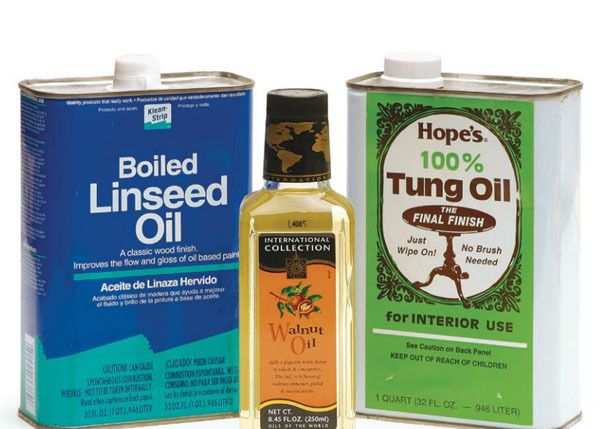All About Oils

Terminology in the coatings industry can be confusing: what is often called an “oil finish” is in fact an oil and varnish mixture. (Watco and Minwax brands are two familiar examples). Examples of oils commonly used in these formulations are linseed, soybean, and tung oil.
The Basics:
• True oils: When pure oil is used as its own finish, it is often called one of the true oils.
• Easy to apply: Even coats with a brush or rag
• Food safe: A good choice for cutting boards and salad bowls
True oils
Vegetable oils play a critical role in the manufacture of finishes, and sometimes they are applied to wood either as a sealer under another finish, or as a stand-alone finish in their own right.
Some true oils, such as tung oil and walnut oil, polymerize (dry) readily by exposure to air. Others, such as boiled linseed oil, have metallic driers added to them to facilitate their curing. At one time, this process was initiated by heating the oil, hence the name. For the purpose of finishing, you should never use raw linseed oil because it will not dry, or cure properly on the wood surface.
Easy to apply
Oil finishes are easy to apply by brush or rag. Typically, you flood the surface of the wood, allow some time for it to penetrate, and then wipe off the excess. This finishing routine is usually repeated one or two more times, at most, and oil finishes are appreciated for their natural looking appearance. They offer only marginal protection against damage by moisture, chemicals, or abrasion, but when damage does occur, oil finishes are fairly easy to repair.
Food safe
Mineral oil, a non-drying, non-toxic petroleum derivative, is sometimes used as a finish coating for butcher blocks or kitchen counters on which food will be prepared. Given that it is sold as a pharmaceutical laxative, mineral oil deserves its distinction as the only wood finish that is entirely edible in its liquid form.
Fine Woodworking Recommended Products

Waterlox Original

Odie's Oil

Bumblechutes Bee’Nooba Wax






















Log in or create an account to post a comment.
Sign up Log in